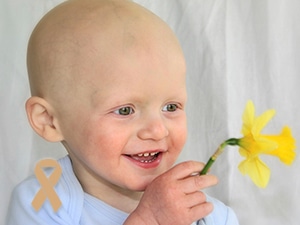September is Childhood Cancer Awareness Month
join with the aacr to find better ways to prevent and treat childhood cancers
These are words a parent never wants to hear: “Your child has cancer.”

While relatively rare, pediatric cancers are the leading cause of death from disease in children between the ages of 1 and 14 years.
Over the past several decades, the five-year survival rate for pediatric cancer has improved, increasing from 58-68% in the 1970s to 83-88% in recent years.
Despite those advances, approximately 1,600 children and adolescents in the United States die of cancer each year.
The most common types of cancers in children are acute lymphocytic leukemia (ALL), brain and other central nervous system (CNS) tumors, lymphoma, and neuroblastoma. Taken together, these cancers account for about half of the new cases each year.
HOW RESEARCH is helping CHILDREN WITH CANCER
- Michael Methner of East Brunswick, New Jersey, was diagnosed with a brain tumor at the age of two. After years of grueling chemotherapy and other treatments, he and his parents are seeing progress with a new molecularly targeted treatment. Read his story in the AACR Cancer Progress Report 2024.
- Investigational treatments were effective for Parker Shaw of Lakeside, California, as he and his parents dealt with a neuroblastoma that had spread to 87 percent of his bone marrow when he was six years old. He’s now 17 and thriving. Read his profile in the AACR Cancer Progress Report 2024.
More on childhood cancers
- Most people diagnosed with childhood or adolescent cancer will develop a significant health condition related to their diagnosis or treatment by the time they reach age 45, according to a study. Read more about the outlook for childhood cancer survivors in Cancer Today magazine: The Late Effects of Childhood Cancer.
- The AACR highlights cancer in children, adolescents, and young adults in the AACR Cancer Progress Report 2024, examining topics such as biology of childhood cancers, genetic testing in children with cancer predispositions, research-driven progress against these cancers, and cancer survivorship in children, adolescents, and young adults.
What the AACR is Doing in childhood cancer Research
AACR Conferences
- In September 2024, the AACR and its Pediatric Cancer Working Group held a Special Conference on Pediatric Cancer. The AACR blog, Cancer Research Catalyst, reported on highlights of the conference.
- The AACR Special Conference on Brain Cancer in October 2023 reviewed the latest research on pediatric and adult brain cancers. Attendees discussed new therapeutic and prevention strategies for these malignancies.
Supporting Research
The AACR has recently awarded research grants to investigators pursuing promising research related to pediatric cancers.
- In October 2023, Philadelphia’s “Party with a Purpose,” in conjunction with the AACR, raised money for neuroblastoma research at Children’s Hospital of Philadelphia. See the AACR’s blog, Cancer Research Catalyst, for details: Party with a Purpose Honors Neuroblastoma Researchers.
- Adrienne Long, MD, PhD, of Stanford University, received the 2022 AACR-Conquer Cancer® Foundation of ASCO Young Investigator Award for Translational Cancer Research. Her work involves the identification of T cell receptors (TCRs) aimed at antigens associated with tumors in children. Specifically, she is working to identify high-affinity TCRs with a strong potential for clinical translation in the treatment of Ewing sarcoma.
Pediatric Cancer Working Group
- The AACR sponsors a Pediatric Cancer Working Group (PCWG). Its mission is to establish childhood cancer research as a global priority that is supported by improved funding, the latest technologies, and the best educational strategies.
For more information
Hematologic malignancies and tumors of the brain and central nervous system are the most common childhood cancers. But many others exist. Please see our pages on these and other childhood cancers for more specific information on these diseases and their treatment.


